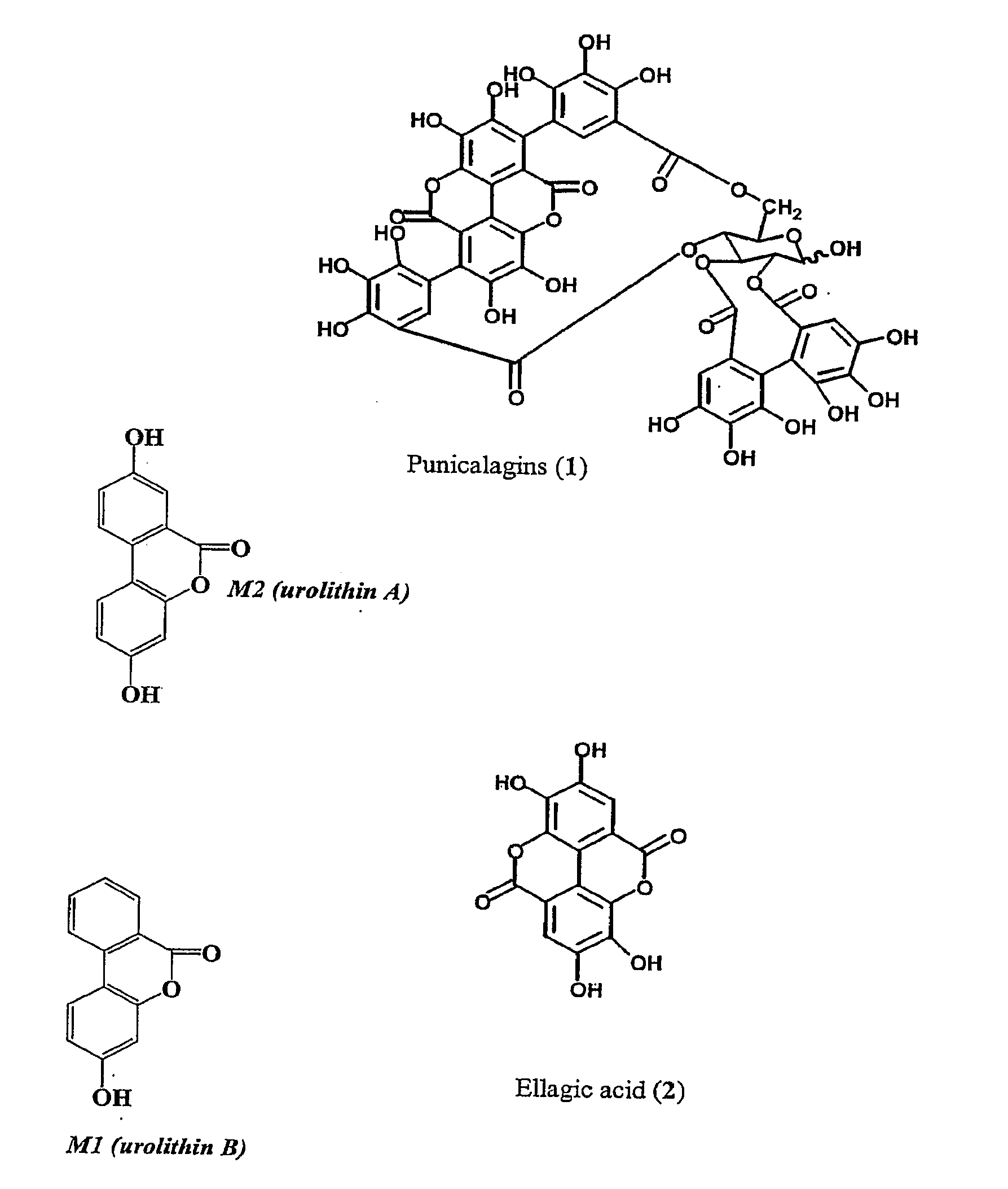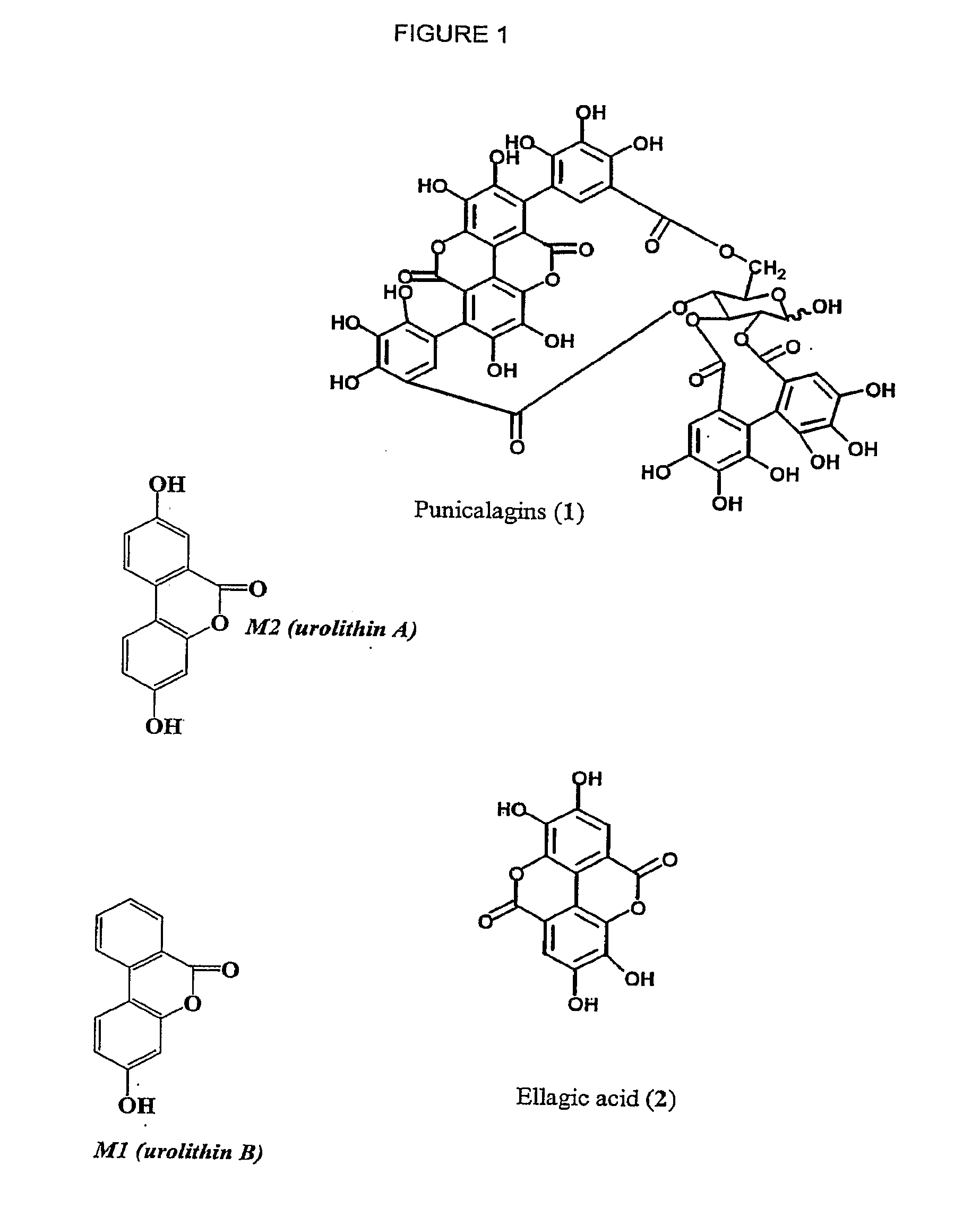Therapeutic uses of urolithins
- Summary
- Abstract
- Description
- Claims
- Application Information
AI Technical Summary
Benefits of technology
Problems solved by technology
Method used
Image
Examples
example 1
Subjects, Materials and Methods
[0060]Reagents and Instruments. All solvents were HPLC grade and purchased from Fisher Scientific Co. (Tustin, Calif.). Ellagic, gallic, formic, phosphoric, 2-bromo-benzoic, 2-bromo-5-methoxybenzoic and acetic acids, resorcinol, potassium dihydrogen phosphate, ABTS (2,2□-aninobis-3ethylbenzothiazoline-6-sulphonic acid diammonium salt), manganese dioxide, Trolox (6-hydroxy-2,5,7,8-tetramethylchroman-2-carboxylic acid), magnesium chloride, Tris HCL, sodium acetate, diethylenetriamine pentaacetic acid (DTPA), deoxyguanosine (dG),β-D-glucuronidase (type X-A from Escherichia coli) and arylsulfatase (type VIII from abalone entrails) were purchased from Sigma-Aldrich (St. Louis, Mo.). The high performance liquid chromatography with ultraviolet detection (HPLC-UV) analyses were carried out on a Waters Alliance 2690 system equipped with a photo diode array (PDA) detector (Waters Corp., Milford, Mass.) and data handling was with Waters Millenium v 3.02 software....
example 2
Effect of Urolithins on Colon Cancer Cells
[0077]Antiproliferative activity. EA and EA-metabolites (gallic and gallagic acids, urolithin B and methylated-urolithin A) were evaluated for antiproliferative activity against the human colon cancer cell line HCT-116. The cells were grown to a concentration of 10,000 cells per well in a 96 well format; and were then resuspended in medium containing vehicle control or the indicated compound: Ellagic acid, urolithin A, methyl urolithin A, or urolithin B, at a concentration of 100 μg / mL. The cells were incubated for 48 hrs, and the viability assayed by the CellTiter-Glo® Luminescent Cell Viability Assay (Technical Bulletin #288, Promega Corp., Madison, Wis.).
[0078]These data, as shown in FIG. 3, demonstrate the efficacy of the ellagitannin metabolites as anti-proliferative agents. The data show that urolithin A is the most active, then ellagic acid, urolithin B and methyl urolithin A.
example 3
Effect of Urolithins on Pancreatic Cancer Cells
[0079]Antiproliferative activity. EA and EA-metabolites (gallic and gallagic acids, urolithin B and methylated-urolithin A) were evaluated for antiproliferative activity against the human pancreatic cancer cell lines ASPC-1 and BXPC-3. The cells were grown to a concentration of 10,000 cells per well; and were then resuspended in medium containing the vehicle control or the indicated compound: Ellagic acid, urolithin A, methyl urolithin A, or urolithin B, at a concentration of 100 μg / mL. The cells were incubated for 48 hrs, and the viability assayed byCeliTiter-Glo® Luminescent Cell Viability Assay (Technical Bulletin #288, Promega Corp., Madison, Wis.).
[0080]These data shown in FIG. 4 demonstrate the efficacy of the ellagitannin metabolites as anti-proliferative agents. The data show that urolithin A is the most active, then ellagic acid, urolithin B and methyl urolithin A.
REFERENCES
[0081]13. Cerda B, Espin J C, Parra S, Martinez P, Tom...
PUM
| Property | Measurement | Unit |
|---|---|---|
| Molar density | aaaaa | aaaaa |
| Molar density | aaaaa | aaaaa |
| Molar density | aaaaa | aaaaa |
Abstract
Description
Claims
Application Information
 Login to View More
Login to View More - R&D
- Intellectual Property
- Life Sciences
- Materials
- Tech Scout
- Unparalleled Data Quality
- Higher Quality Content
- 60% Fewer Hallucinations
Browse by: Latest US Patents, China's latest patents, Technical Efficacy Thesaurus, Application Domain, Technology Topic, Popular Technical Reports.
© 2025 PatSnap. All rights reserved.Legal|Privacy policy|Modern Slavery Act Transparency Statement|Sitemap|About US| Contact US: help@patsnap.com



